An Exploratory Study of Mobile-Based Scenarios for Foreign Language Teaching in Early Childhood
Abstract
:1. Introduction
2. Digital Technologies in Language Learning—A Systematic Review
2.1. Digital Storytelling
- Story jumper (https://www.storyjumper.com/) (accessed on 30 March 2022): Story jumper is an open-source software, also called “writing package”, suitable for teachers. It enables the gradual construction of multimedia teaching material. At the same time, it is a challenge for the teacher of every level. It can be described as a modern, creative tool that helps in writing modern e-books, which have many pages, texts and superscripts, images and designs, music and videos. Story jumper is one of the online digital storytelling tools used by millions of educators and students of all ages around the world. It is a collaborative storytelling site that incorporates three ideas: creating, reading and sharing. High-quality visual software, user-friendly interface and attractive student creation environment. The ease of use and the ability to share/publish the story are the two key features that have made it known to the educational community that shows a preference for it. The user can create the stories from scratch, starting from the cover of the book where he will choose the title, then from the graphics library, he will use characters, images, different backgrounds and designs. This software enhances collaborative learning as it allows teachers and students to receive feedback. The application is free, requires registration (sign up) and supports the Greek language. It has an easy-to-use and simple interface, so it is ideal for young children with obvious pedagogical use. However, it can also be used by older students to create digital narratives on social, environmental, cultural and other issues such as bullying.
- Storybird (https://storybird.com/) (accessed on 30 March 2022): It is a free online learning tool for creating digitally illustrated stories (creative writing) that can be published (embedded) on other websites. The application allows anyone to create visual stories in a very short time, by registering on the site before use. It provides a wide variety of images, which the user can combine and enrich with text in order to create his own illustrated online story. It can be used by students of all ages. Graphics are used by designers and animators from around the world. The stories are supported by visual material (sketches, animations) made by professionals and can be published (embedded) on other websites (e.g., blogs). Included lessons are done with video tutorials, quizzes, and tips from authors. Allows education and writing texts for novels, songs, poems, screenplays, etc. Registration on the site is required before use. Attending classes and creating stories are free. The courses are divided into learning levels. Downloading or printing a story costs money. The Storybird does not support the enrichment of stories with audio features such as voice or music. Additionally, it does not allow digital history to be stored locally on the user’s computer.
- Book Creator (https://bookcreator.com/) (accessed on 30 March 2022): Book Creator is designed to teach students by getting them excited about creating their own books on the topics they are learning about. Students can upload images, choose from emojis, make recordings and videos, and create and then share a finished book they wrote.
- My Story Maker (https://www.mystory.co/) (accessed on 30 March 2022): My Storymaker is a free online application that allows users to create their own story by selecting a character and a target. Learners choose characters, sets and objects. The stories are enriched with the interaction of the heroes with each other and with the objects that participate in the story. The story is stored in the form of an interactive book, which can be saved online, read or edited, printed and shared with friends online. The simplest application of storytelling and storytelling for children in the classroom and beyond. It is excellent for children aged 5–12 years. It is possible to separate the story of each child in his own library. Sharing on the Web, Facebook, Twitter, ePub and in movie format. Export and share the story with audio and video on YouTube. Easy and fun user interface. Sharing features are some of the most powerful in the App Store. Teachers and parents alike love this app, creating ePubs, Facebook/Twitter, exporting iBooks and more.
- My Storybook (https://www.mystorybook.com) (accessed on 30 March 2022): MyStorybook is a digital online tool that students can use to build and share their own storybooks. The ease of use is a key feature that has made it known to the educational community and shows a preference for it. The user creates the stories from scratch, starting from the cover of the book where he will choose the title, then from the graphics library, he will use characters, images, different backgrounds and designs. The My Storybook tool is an easy-to-use tool for preschoolers aged 4–6 years that guides them step by step in creating their own book. With this tool, children compose a story, and its cover, select images from the graphic library of the tool or from their own archive and are gradually introduced to the concept of illustration and narration. Tool requires registration with an e-mail account and accepts text in Greek. Then, when the story is ready, it is published on the internet, and for a small fee, it can be printed as a regular book.
- Voki for Foreign Language (https://l-www.voki.com/) (accessed on 30 March 2022): Voki is an online tool that offers the ability to create digital representations of subjects (avatars) on the Internet with the ability to speak, which can be published on any blog, website or profile and integrated into the activities of various subjects. It is a free online program that belongs to the ten best educational tools of Web 2.0 [25]. The use of Voki in language teaching is considered to be very helpful, as it enables students to practice with different voices (male or female) and with English accents. These familiarization possibilities would not be possible with conventional supervisors and the technological means that a school classroom can have. It is suitable for use by students of all ages. Suitable for creating lesson plans in English.
2.2. Serious Games—Gamification Tools
- Kahoot (https://kahoot.it/) (accessed on 30 March 2022): It is a program that allows you to easily construct a question and answer several games. You can design your own quizzes or join one of the many that have already been established and are accessible for a variety of ages and levels. It provides rankings, learning, and entertainment at the same time. It is a free online platform for creating gamification games for students of all ages and may also be used in special education. It is compatible with all mobile devices. There are two options: The classic mode in which each student uses his own device or the Team mode in which students play in teams using one device. Using the Drops language learning app, users learn a new language.
- Edmodo (https://new.edmodo.com/) (accessed on 30 March 2022): Edmodo is the closest thing to a social network for educational purposes, and with the ability to distribute badges to students. Teachers are able to implement the necessary gamification in the classroom. It generates challenges and exercises and awards pins to several pupils, not just the best. It is a free online platform that can be used to create gamification games to encourage students to practice language skills such well as spelling and grammar. This platform may also be used to enhance oral skills of a foreign language which is being taught through conversations. It is a multifunctional tool that can be used by a teacher since it also provides assessment, formative assessment, classroom management, instructional strategies as well as parent communication. It is suitable for students K-12.
- Baamboozle (https://www.baamboozle.com/games) (accessed on 30 March 2022): A free website that enables a foreign language teachers to choose between 500,000 available games, covering vocabulary, grammar, tenses, and sentence structure that are made by other teachers. The teachers may also create their own Baamboozle games, adjusting them to their lessons. Baamboozle enables students to compete against each other, as students win points for each correct answer. Its special feature, which students enjoy, is that points can be swapped and stolen from their classmates. Games that are created on this platform can be applied to all ages.
- Mingoville (http://www.savivo.com/) (accessed on 30 March 2022): Mingoville is a web-based platform for language learning targeted at primary school learners (ages 9–10). The programme was introduced in Denmark in 2006 as “the world’s most comprehensive English language course online for kids of all ages” (Sorensen, 2007). The course has been translated into 31 languages and is sold and marketed worldwide. Mingoville is based on a narrative concept built on the familiar world of the family. The characters of the game are citizens of the simulated world of Mingoville—a city inhabited by flamingos.
2.3. Augmented Reality—Virtual Reality Tools
- AR Flashcards-Animal Alphabet (https://arflashcards.com/) (accessed on 30 March 2022): AR Flashcards are a way to interact and make Flashcards more entertaining for toddlers and preschoolers. This application is compatible with iOS devices.
- Mondly AR (https://www.mondly.com/ar) (accessed on 30 March 2022): Mondly’s AR app offers virtual lessons and useful, real-life conversations in 15 languages. A virtual teacher has conversations with the learner, processes the spoken language, and offers instant feedback. You can get instant feedback on your pronunciation and you get the opportunity to practice real conversations—and hear them played back to you in conversation form. With Mondly AR, users get to learn differently. There are life-size animals and other objects that appear in the virtual learning room. This application is suitable for all ages and along with the app a headset, a touchpad and a Gear VR Controller are needed in order to play the game.
- Catchy Words AR (https://apps.apple.com/us/app/catchy-words-ar/id1266039244) (accessed on 30 March 2022): Through this application students walk around and catch the letters with the device and solve the word. It is a free application suitable for elementary school students. It is compatible only with iOS 11.0 or later software.
- Narratorar.com (https://www.narratorar.com.au/) (accessed on 30 March 2022): Children connect to their written words as the Narrator AR app launches letters off the page in augmented reality (AR). It is an offline, ad-free app suitable for preschoolers and can be downloaded free from AppStore and Google Play.
- House of Languages (https://www.oculus.com/experiences/gear-vr/1129567930394285/) (accessed on 30 March 2022): Through the House of Languages, someone can learn English, German or Spanish in a fun and creative way. The learner is taught by Mr. Woo, and he can visit the airport, the zoo, the café, and some other places in virtual reality. It is a highly effective way of learning new basic vocabulary. This application is suitable for all ages. Equipment such as a headset and a touchpad are needed to play the game.
- Immerse Me (https://immerseme.co) (accessed on 30 March 2022): ImmerseMe is another academic language tool. With this app, you can choose between nine different languages and from over 3000 different scenarios. The languages someone can learn with ImmerseMe are German, Spanish, French, English, Japanese, Chinese, Italian, Greek, and Indonesian. It is classified into three levels: Beginner, Intermediate and Advanced, and is mostly addressed to older students and adults. Equipment needed: Android Cardboard, Vive, Rift or Gear VR.
- Virtual Speech (https://virtualspeech.com/courses/english-for-business-vr) (accessed on 30 March 2022): English is the major language for communication in the world of international business. The VirtualSpeech English for Business course focuses on this sector, allowing people from around the world to boost their listening and speaking skills in a business context. VirtualSpeech is focused on improving your communication skills. In other words, their goal is to make you a more confident speaker and a better listener. Its voice analysis technology can analyze your pace of voice and pick up hesitant words, giving you feedback on how to speak more clearly.
- FluentU (https://www.fluentu.com/) (accessed on 30 March 2022): FluentU takes authentic videos—like music videos, movie trailers, news and inspiring talks—and turns them into personalized language learning lessons. FluentU’s video player supports your students so they can learn on their own. 10 languages and 10,000+ videos that your students will love. Students can access FluentU through the website or iOS/Android mobile apps.
3. Educational Tool Comparison—Selection of Language Tools
- Relevance and authenticity;
- Proper navigation;
- Accessibility;
- Open-source;
- User input;
- Image and sound quality;
- Platforms;
- Age;
- Multi-language;
- Collaboration;
- Extra features.
4. Empirical Study at School
- An age group of 4–6 years was done in a real classroom in a section of Public Kindergarten Kefalonia and the subjects studied were a total of 19. The children were already familiar with the use of the computer, with similar software and digital tools of preschool age.
- An age group of primary school students to supplement the vocabulary of the “animals” unit, which was completed within one week. We divided students into groups of 2–3, and students played with the apps in turns.
- There is an age group of young learners or beginner learners (10+ age) of Spanish as a foreign language.
5. Data Analysis and Results
- The majority of students perceived the experience as a positive educational opportunity to gain new knowledge about language learning.
- Students gave the Language apps an eight on a scale of 1 to 10 for their ability to entice them to continue using them after two minutes.
- Most participants expressed a desire for social media interaction while stating that the interactive content creation process aided in language learning promotion.
- On a scale of 1 to 10, the students gave the applications an 8 for design.
- Regarding the audiovisual material (images, videos, and sound effects), it was delightful, enjoyable, unique and collaborative.
- The results indicate that the applications provide significantly more features than other educational applications, significantly increase learners’ willingness to learn, and provide a fully authentic experience.
- Additionally, students agree that the applications do not take up much space in the device’s storage memory, do not significantly reduce the device’s battery life, and the mobile device’s screen size is adequate.
- Installing the application was more straightforward than using it.
- On a scale of 1 to 10, students scored nearly 10 for their ability to comprehend the language procedure and its effect on their desire to learn a new language.
- Some additional features were identified, such as the need for other donation games, additional activities to complete, a more interactive experience, and different topics.
6. Conclusions
Author Contributions
Funding
Institutional Review Board Statement
Informed Consent Statement
Data Availability Statement
Conflicts of Interest
Appendix A. Questionnaire [1.2]
Appendix A.1. Socio-Demographic Characteristics
- Gender
- (i) Male (ii) Female
- Age
- (i) 4–6 (ii) 7–12 (iii) 13–15 (iv) 16–18 (v) 18+
- Residence
- ……………
- Familiarity with the use of new technologies
- (i) Low (ii) Medium (iii) High (iv) Other
- What kind of mobile device do you use?
- (i) Smartphone Android (ii) Tablet Android (iii) iPhone (iv) iPad (v) Other
- Do you have at least one social media account?
- (i) Yes (ii) No (iii) Other
Appendix A.2. User Experience
- Have you used any digital educational applications on your mobile phone?
- (i) Yes (ii) No (iii) Other
- Do you frequently use educational tools—apps?
- (i) Not at all (ii) Rarely (iii) Often (iv) Very often (v) Other
- Do you like experimenting with new applications?
- (i) 1 = Not at all (ii) 10 = Very much (1–10 linear scale)
- If you haven’t used any educational tools, what is the reason?
- (i) They are not easy to use (ii) It didn’t occur (iii) There is not enough material relevant to my interests (iv) Other
- How appealing do you find the design of the application?
- (i) 1 = Not at all (ii) 10 = Very much (1–10 linear scale)
- Please evaluate the AUDIOVISUAL material of the application (images, videos, sound effects, virtual tour, etc.):
- (i) Is it fun? (ii) Is it unique? (iii) Is it pleasant? (iv) Is it collaborative? (multiple choice grid)
- Please evaluate the application based on the following:
- (i) It offers more features than other educational applications that I have tried or heard (ii) It increases the willingness to learn (iii) It offers an authentic experience (multiple choice grid)
- Please tell us how much you agree with the following:
- (i) The personal data collected through the application is safe (ii) The application does not consume much space in the storage memory of the device (iii) The application does not significantly reduce the battery life of the device (iv) The screen size of the mobile device was appropriate/sufficient (multiple choice grid)
- How would you rate each of the following services of the application?
- (i) Graphics (ii) Interaction (iii) Collaboration (iv) Video (multiple choice grid)
- Please let us know how easy it was:
- (i) To install the application on your device (ii) To use the application (multiple choice grid)
- Did the app help you understand the language as described during the trial?
- (i) 1 = Not at all (ii) 10 = Very much (1–10 linear scale)
- Would you recommend to a friend to buy the educational app?
- (i) 1 = Definitely no (ii) 10 = Definitely yes (1–10 linear scale)
- Does the experience you gained while using the application affect your intention to learn a language?
- (i) 1 = Definitely no (ii) 10 = Definitely yes (1–10 linear scale)
- What extra features would you like in an educational app?
- ………..
References
- Lykiardopoulou, A.; Lykiardopoulou, I.; Konstantakis, M.; Iliadis, G. Thematic Teaching of English as a Foreign Language Combining Cross-Cultural Knowledge and Digital Media Tools through Digital Storytelling and Serious Games. In Proceedings of the 11th International Conference in Open & Distance Learning, Athens, Greece, 26–28 November 2021; Volume 11, pp. 161–168. [Google Scholar]
- Konstantakis, M. From Physical to Digital Classroom Using Digital Storytelling and Serious Games to Increase Children’s Participation: An Interactive Lesson Plan through Padlet Web Tool. In Proceedings of the 11th International Conference in Open & Distance Learning, Athens, Greece, 26–28 November 2021; Volume 11, pp. 21–32. [Google Scholar]
- Konstantakis, M.; Caridakis, G. Adding Culture to UX: UX Research Methodologies and Applications in Cultural Heritage. J. Comput. Cult. Herit. 2020, 13, 4. [Google Scholar] [CrossRef] [Green Version]
- Kukulska-Hulme, A. Personalization of Language Learning through Mobile Technologies; Cambridge University Press: Cambridge, UK, 2016. [Google Scholar]
- Bradley, N.; Jadeski, L.; Newton, G.; Ritchie, K.; Merrett, S.; Bettger, W. The Use of a Learning Management System (LMS) to Serve as the Virtual Common Space of a Network for the Scholarship of Teaching and Learning (SoTL) in an Academic Department. Educ. Sci. 2013, 3, 136–146. [Google Scholar] [CrossRef]
- Tunmibi, S.; Aregbesola, A.; Adejobi, P.; Ibrahim, O. Impact of E-Learning and Digitalization in Primary and Secondary Schools. J. Educ. Pract. 2015, 6, 53–58. [Google Scholar]
- Husár, J.; Dupláková, D. Evaluation of Foreign Languages Teaching in LMS Conditions by Facility and Discrimination Index. TEM J. 2016, 5, 44. [Google Scholar]
- Mitaľ, D.; Dupláková, D.; Duplák, J.; Mitaľová, Z.; Radchenko, S. Implementation of Industry 4.0 Using E-Learning and M-Learning Approaches in Technically-Oriented Education. Assoc. Inf. Commun. Technol. Educ. Sci. 2021, 10, 368–375. [Google Scholar] [CrossRef]
- Sáiz-Manzanares, M.C.; Marticorena-Sánchez, R.; Muñoz-Rujas, N.; Rodríguez-Arribas, S.; Escolar-Llamazares, M.-C.; Alonso-Santander, N.; Martínez-Martín, M.; Mercado-Val, E.I. Teaching and Learning Styles on Moodle: An Analysis of the Effectiveness of Using Stem and Non-Stem Qualifications from a Gender Perspective. Sustainability 2021, 13, 1166. [Google Scholar] [CrossRef]
- Töröková, M.; Dupláková, D.; Török, J.; Duplák, J. Application Use of Augmented Reality in the Educational Process. SAR J. 2021, 4, 14–18. [Google Scholar] [CrossRef]
- Ezaldeen, H.; Misra, R.; Bisoy, S.K.; Alatrash, R.; Priyadarshini, R. A Hybrid E-Learning Recommendation Integrating Adaptive Profiling and Sentiment Analysis. J. Web Semant. 2022, 72, 100700. [Google Scholar] [CrossRef]
- Alvarado, N.C.; Coelho, D.; Dougherty, E. Mobile Apps for ELLs: Supporting Language Learning with Engaging Digital Tools. Argent. J. Appl. Linguist. 2016, 4, 43–58. [Google Scholar]
- Lathem, S. Learning Communities and Digital Storytelling: New Media for Ancient Tradition. In Society for Information Technology & Teacher Education International Conference; Association for the Advancement of Computing in Education (AACE): Chesapeake, WV, USA, 2005; pp. 2286–2291. [Google Scholar]
- Robin, B.R. The Power of Digital Storytelling to Support Teaching and Learning. Digit. Educ. Rev. 2016, 30, 17–29. [Google Scholar]
- Alismail, H.A. Integrate Digital Storytelling in Education. J. Educ. Pract. 2015, 6, 126–129. [Google Scholar]
- Nam, C.W. The Effects of Digital Storytelling on Student Achievement, Social Presence, and Attitude in Online Collaborative Learning Environments. Interact. Learn. Environ. 2017, 25, 412–427. [Google Scholar] [CrossRef]
- Trichopoulos, G.; Aliprantis, J.; Konstantakis, M.; Michalakis, K.; Mylonas, P.; Voutos, Y.; Caridakis, G. Augmented and Personalized Digital Narratives for Cultural Heritage under a Tangible Interface. In Proceedings of the 2021 16th International Workshop on Semantic and Social Media Adaptation & Personalization (SMAP), Corfu, Greece, 4–5 November 2021; pp. 1–5. [Google Scholar]
- Nair, V.; Yunus, M.M. A Systematic Review of Digital Storytelling in Improving Speaking Skills. Sustainability 2021, 13, 9829. [Google Scholar] [CrossRef]
- Belda-Medina, J. Promoting Inclusiveness, Creativity and Critical Thinking through Digital Storytelling among EFL Teacher Candidates. Int. J. Incl. Educ. 2022, 26, 109–123. [Google Scholar] [CrossRef]
- Sadik, A. Digital Storytelling: A Meaningful Technology-Integrated Approach for Engaged Student Learning. Educ. Technol. Res. Dev. 2008, 56, 487–506. [Google Scholar] [CrossRef]
- Kahraman, A.D. Animation Use as an Educational Material and Animation Techniques. Online J. Art Des. 2015, 3, 1–12. [Google Scholar]
- Robin, B.R. Digital Storytelling: A Powerful Technology Tool for the 21st Century Classroom. Theory Pract. 2008, 47, 220–228. [Google Scholar] [CrossRef]
- Ezeh, C. A Comparison of Storyjumper with Book Creator, and Storybird for Multimodal Storytelling. SSRN 2021, 24, 1–9. [Google Scholar]
- Kazazoglu, S.; Bilir, S. Digital Storytelling in L2 Writing: The Effectiveness of “Storybird Web 2.0 Tool”. Turkish Online J. Educ. Technol. 2021, 20, 44–50. [Google Scholar]
- Towndrow, P.A.; Pereira, A.J. Reconsidering Literacy in the 21st Century: Exploring the Role of Digital Stories in Teaching English to Speakers of Other Languages. RELC J. 2018, 49, 179–194. [Google Scholar] [CrossRef]
- Riedel, C. Top 10 Web 2.0 Tools for Young Learners. THE J. 2009, 1, 45–78. [Google Scholar]
- Chiu, Y.; Kao, C.; Reynolds, B.L. The Relative Effectiveness of Digital Game-Based Learning Types in English as a Foreign Language Setting: A Meta-Analysis. Br. J. Educ. Technol. 2012, 43, 4. [Google Scholar] [CrossRef]
- Ferdig, R.E. Assessing Technologies for Teaching and Learning: Understanding the Importance of Technological Pedagogical Content Knowledge. Br. J. Educ. Technol. 2006, 37, 749–760. [Google Scholar] [CrossRef]
- Konstantakis, M.; Kalatha, E.; Caridakis, G. Cultural Heritage, Serious Games and User Personas Based on Gardner’s Theory of Multiple Intelligences: “The Stolen Painting” Game. In International Conference on Games and Learning Alliance; Springer: Berlin/Heidelberg, Germany, 2019; pp. 490–500. [Google Scholar]
- Riemer, V.; Schrader, C. Learning with Quizzes, Simulations, and Adventures: Students’ Attitudes, Perceptions and Intentions to Learn with Different Types of Serious Games. Comput. Educ. 2015, 88, 160–168. [Google Scholar] [CrossRef]
- Deterding, S.; Khaled, R.; Nacke, L.E.; Dixon, D. Gamification: Toward a Definition. In Proceedings of the CHI 2011 Gamification Workshop Proceedings, Vancouver, BC, Canada, 7–12 May 2011; Volume 12, pp. 12–15. [Google Scholar]
- Landers, R.N. Developing a Theory of Gamified Learning: Linking Serious Games and Gamification of Learning. Simul. Gaming 2014, 45, 752–768. [Google Scholar] [CrossRef]
- Oliveira, M.; Petersen, S. The Choice of Serious Games and Gamification. In International Conference on Serious Games Development and Applications; Springer: Berlin/Heidelberg, Germany, 2014; pp. 213–223. [Google Scholar]
- de Freitas, S.; Liarokapis, F. Serious Games: A New Paradigm for Education? In Serious Games and Edutainment Applications; Springer: Berlin/Heidelberg, Germany, 2011; pp. 9–23. [Google Scholar]
- Kalatha, E.; Aliprantis, J.; Konstantakis, M.; Michalakis, K.; Moraitou, T.; Caridakis, G. Cultural Heritage Engagement via Serious Games: The ARCADE Augmented Reality, Context Aware, Linked Open Data PErsonalized Ecosystem. In Proceedings of the 1st International CICMS Conference, Kuşadası, Turkey, 4–5 May 2018; p. 309. [Google Scholar]
- Azuma, R.; Baillot, Y.; Behringer, R.; Feiner, S.; Julier, S.; MacIntyre, B. Recent Advances in Augmented Reality. IEEE Comput. Graph. Appl. 2001, 21, 34–47. [Google Scholar] [CrossRef] [Green Version]
- Yuen, S.C.-Y.; Yaoyuneyong, G.; Johnson, E. Augmented Reality: An Overview and Five Directions for AR in Education. J. Educ. Technol. Dev. Exch. 2011, 4, 11. [Google Scholar] [CrossRef]
- Lee, K. Augmented Reality in Education and Training. TechTrends 2012, 56, 13–21. [Google Scholar] [CrossRef]
- Akçayır, M.; Akçayır, G. Advantages and Challenges Associated with Augmented Reality for Education: A Systematic Review of Literature. Educ. Res. Rev. 2017, 20, 1–11. [Google Scholar] [CrossRef]
- Ntagiantas, A.; Manousos, D.; Konstantakis, M.; Aliprantis, J.; Caridakis, G. Augmented Reality Children’s Book for Intangible Cultural Heritage through Participatory Content Creation and Promotion. Case Study: The Pastoral Life of Psiloritis as a UNESCO World Geopark. In Proceedings of the 2021 16th International Workshop on Semantic and Social Media Adaptation & Personalization (SMAP), Corfu, Greece, 4–5 November 2021; pp. 1–4. [Google Scholar]
- Ardiny, H.; Khanmirza, E. The Role of AR and VR Technologies in Education Developments: Opportunities and Challenges. In Proceedings of the 2018 6th RSI International Conference on Robotics and Mechatronics (IcRoM), Tehran, Iran, 23–25 October 2018; pp. 482–487. [Google Scholar]
- Tzanavari, A.; Tsapatsoulis, N. Affective, Interactive and Cognitive Methods for E-Learning Design: Creating an Optimal Education Experience; IGI Global: Hershey, PA, USA, 2010. [Google Scholar]
- Peachey, N. Criteria for Evaluating Web Tools and Apps. Online Tersedia. 2013. Available online: http://nikpeachey.blogspot.com/2013/09/evaluating (accessed on 30 March 2022).
- Papadakis, S. Tools for Evaluating Educational Apps for Young Children: A Systematic Review of Literature. Interact. Technol. Smart Educ. 2021, 18, 18–49. [Google Scholar] [CrossRef]
- Konstantakis, M.; Michalakis, K.; Aliprantis, J.; Kalatha, E.; Caridakis, G. Formalising and Evaluating Cultural User Experience. In Proceedings of the 12th International Workshop on Semantic and Social Media Adaptation and Personalization, SMAP 2017, Bratislava, Slovakia, 9–10 July 2017. [Google Scholar] [CrossRef]
- Konstantakis, M.; Aliprantis, J.; Teneketzis, A.; Caridakis, G. Understanding User Experience Aspects in Cultural Heritage Interaction. In Proceedings of the 22nd Pan-Hellenic Conference on Informatics, Athens, Greece, 29 November–1 December 2018; pp. 267–271. [Google Scholar]

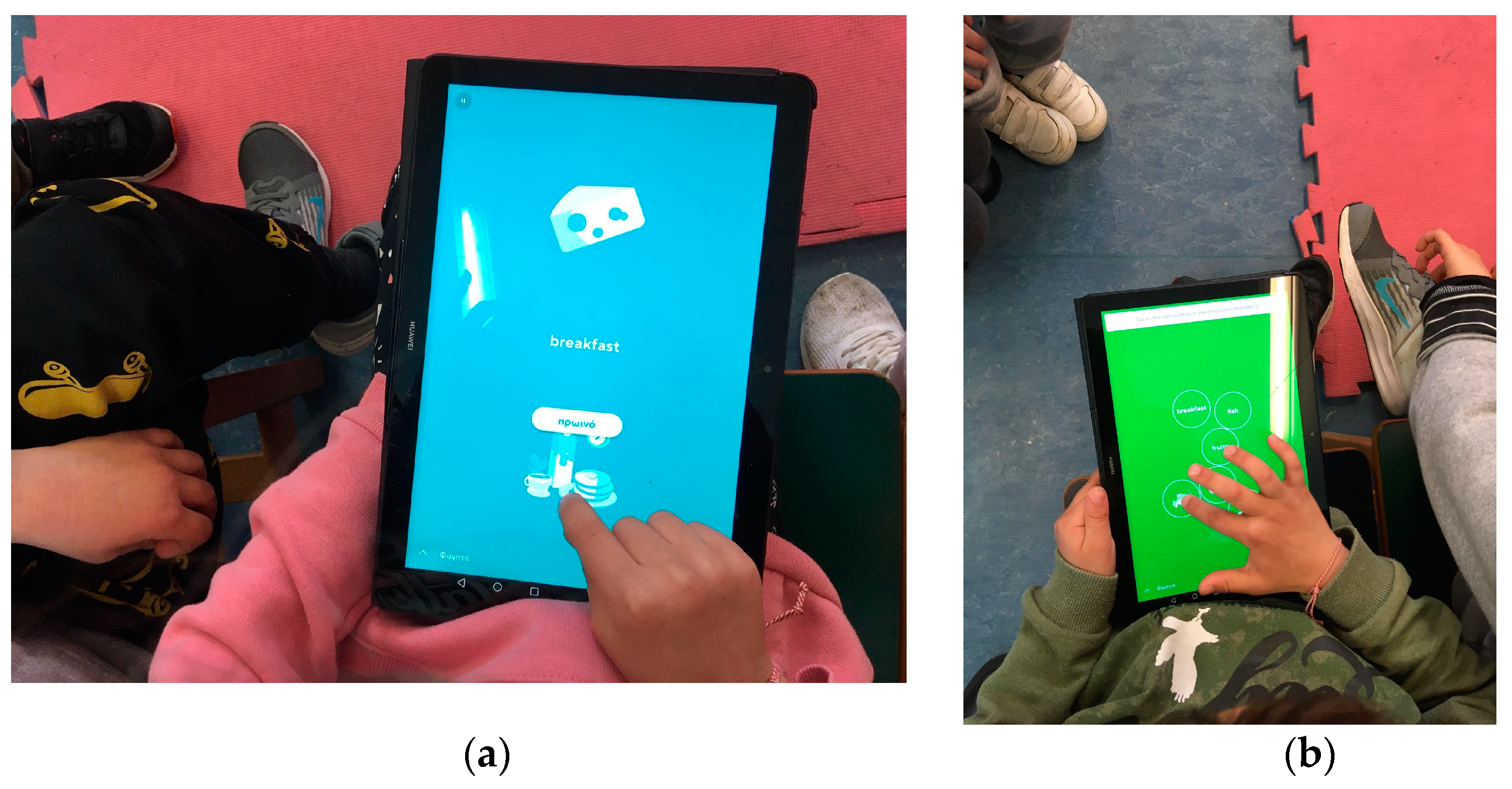

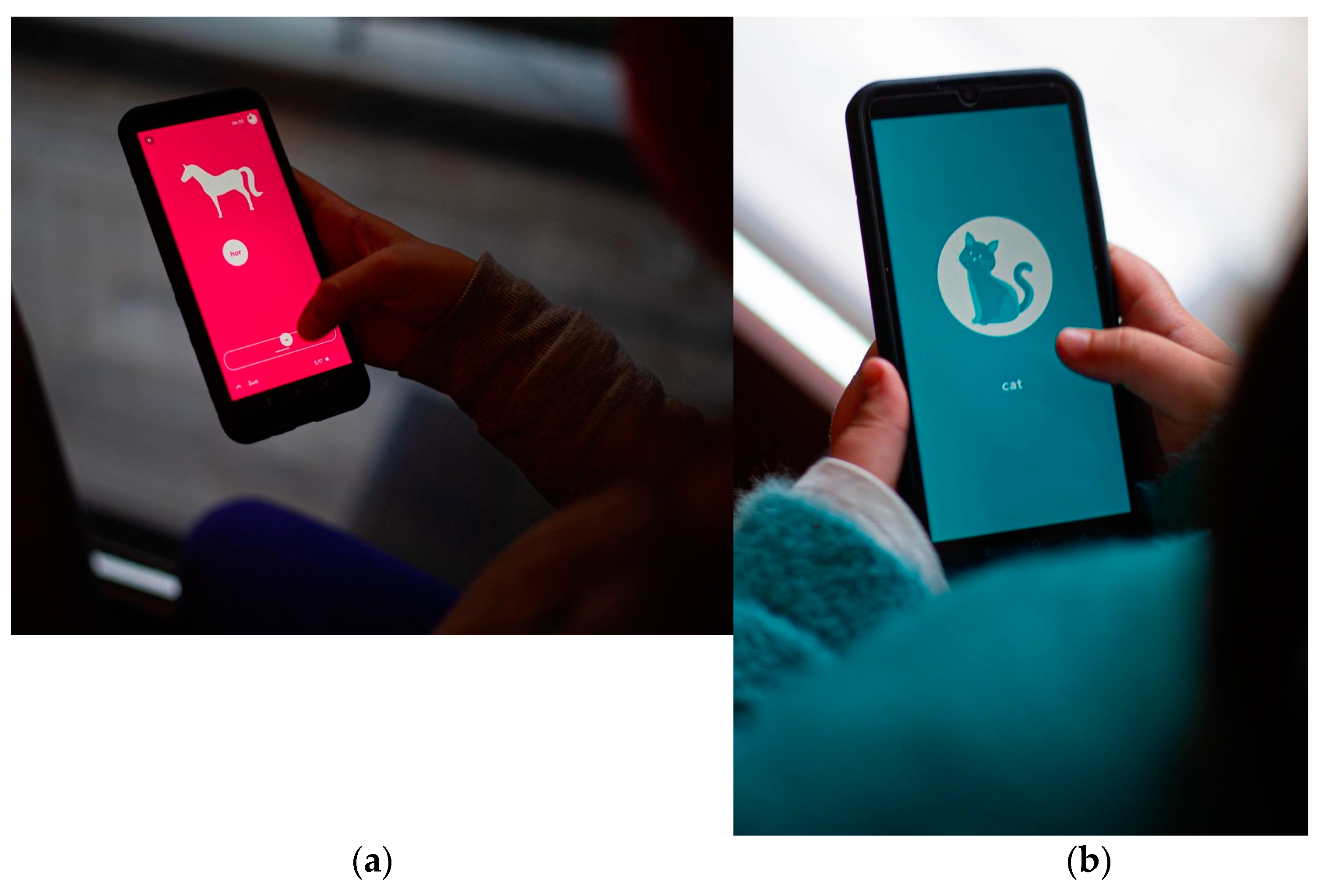
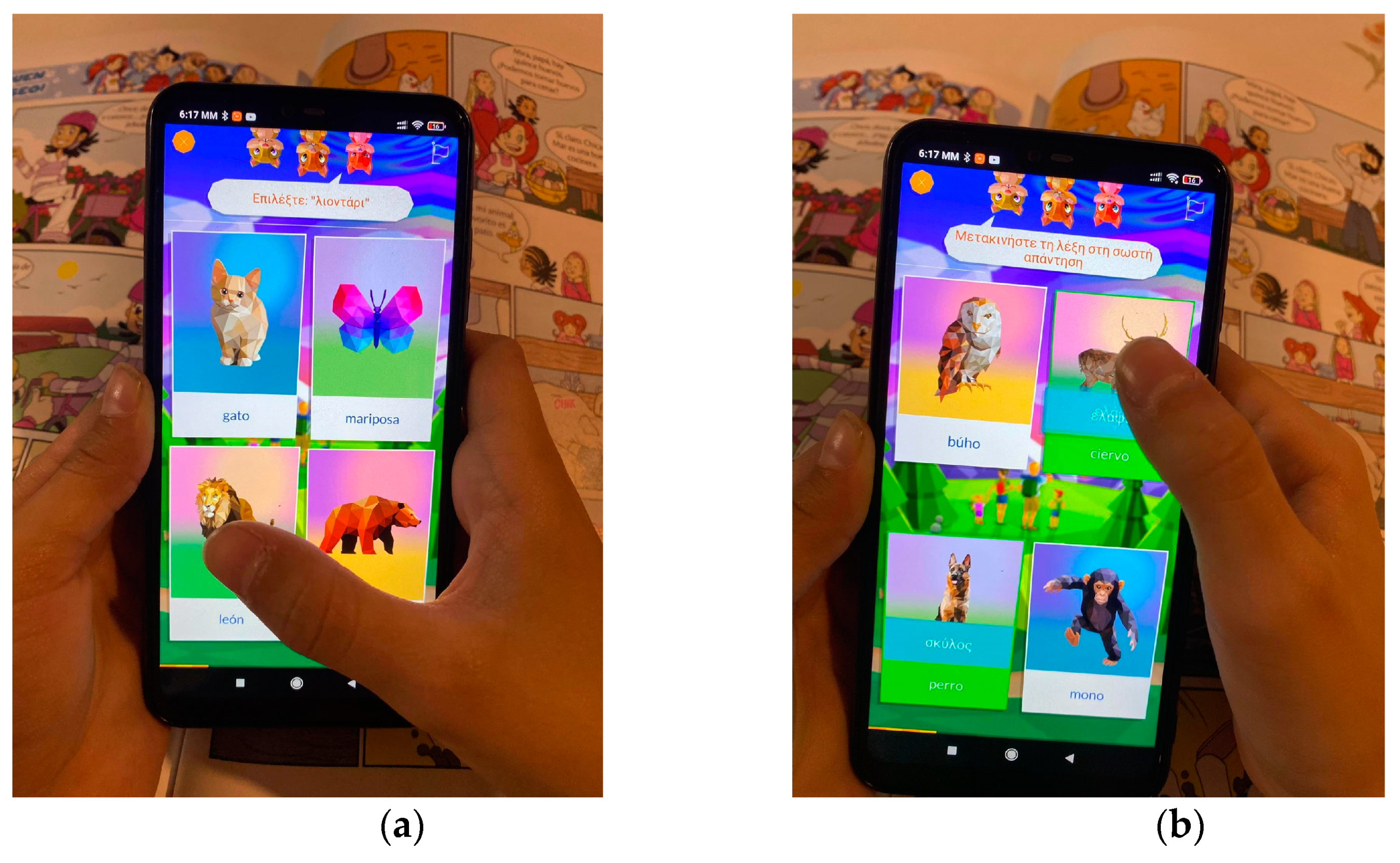

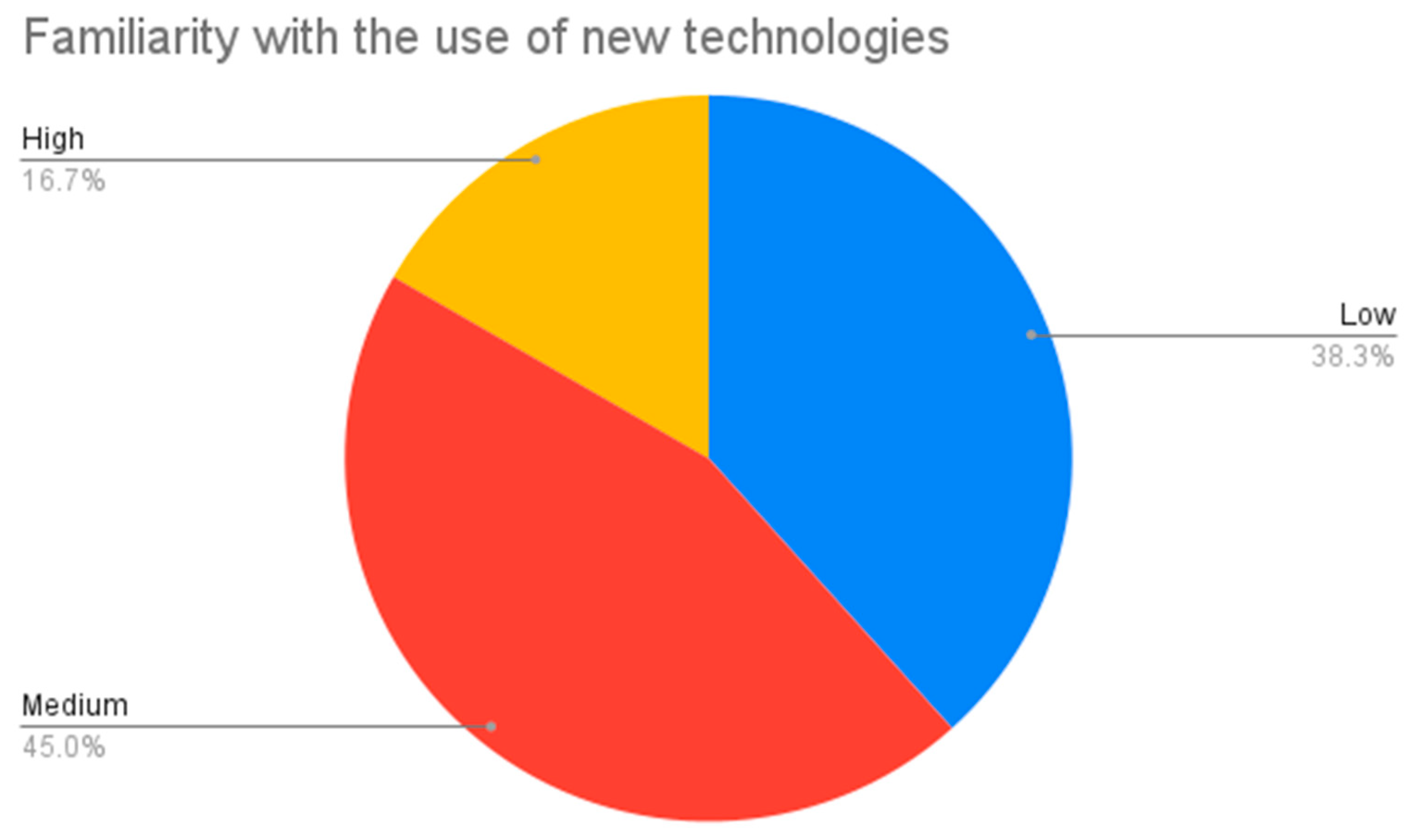
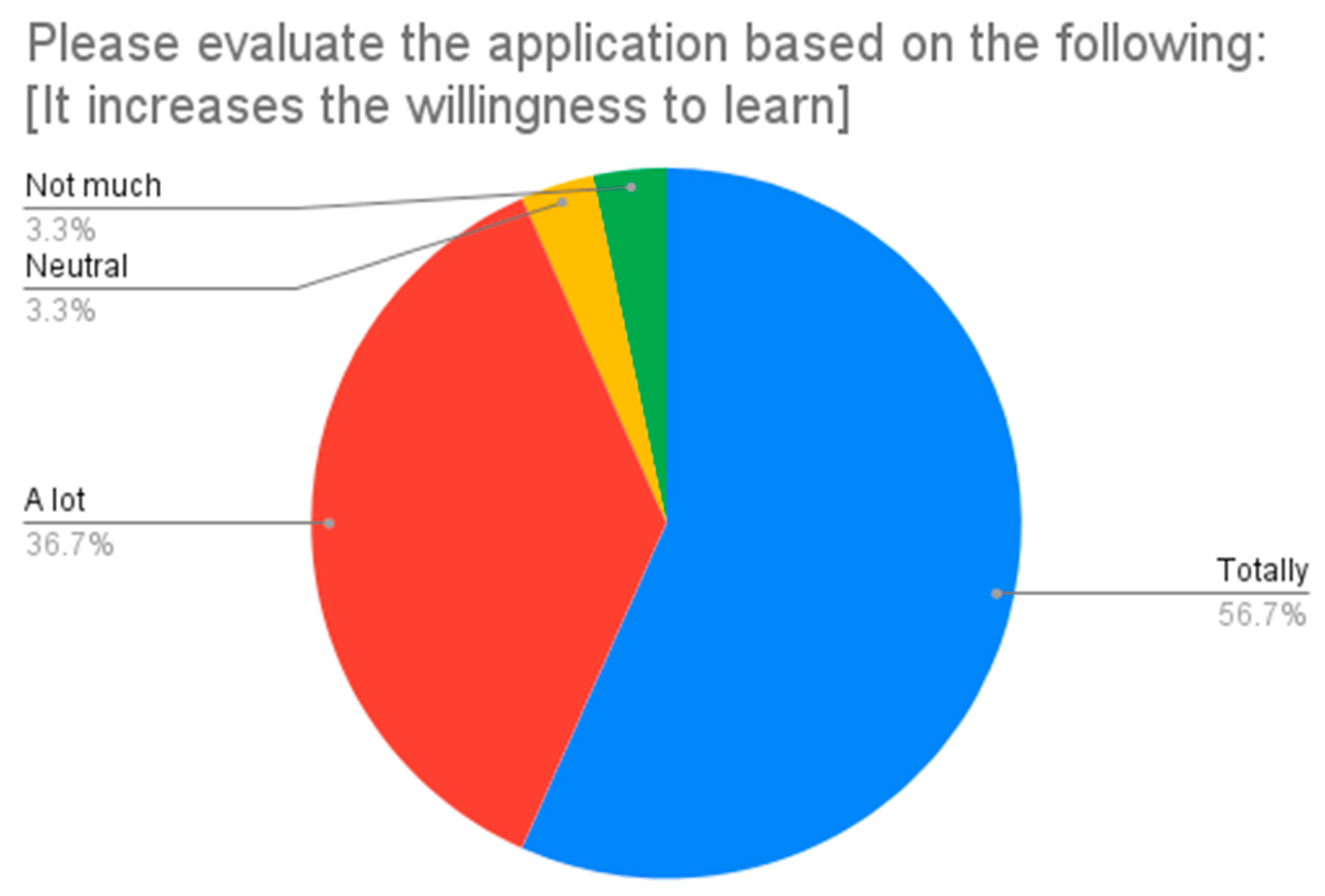
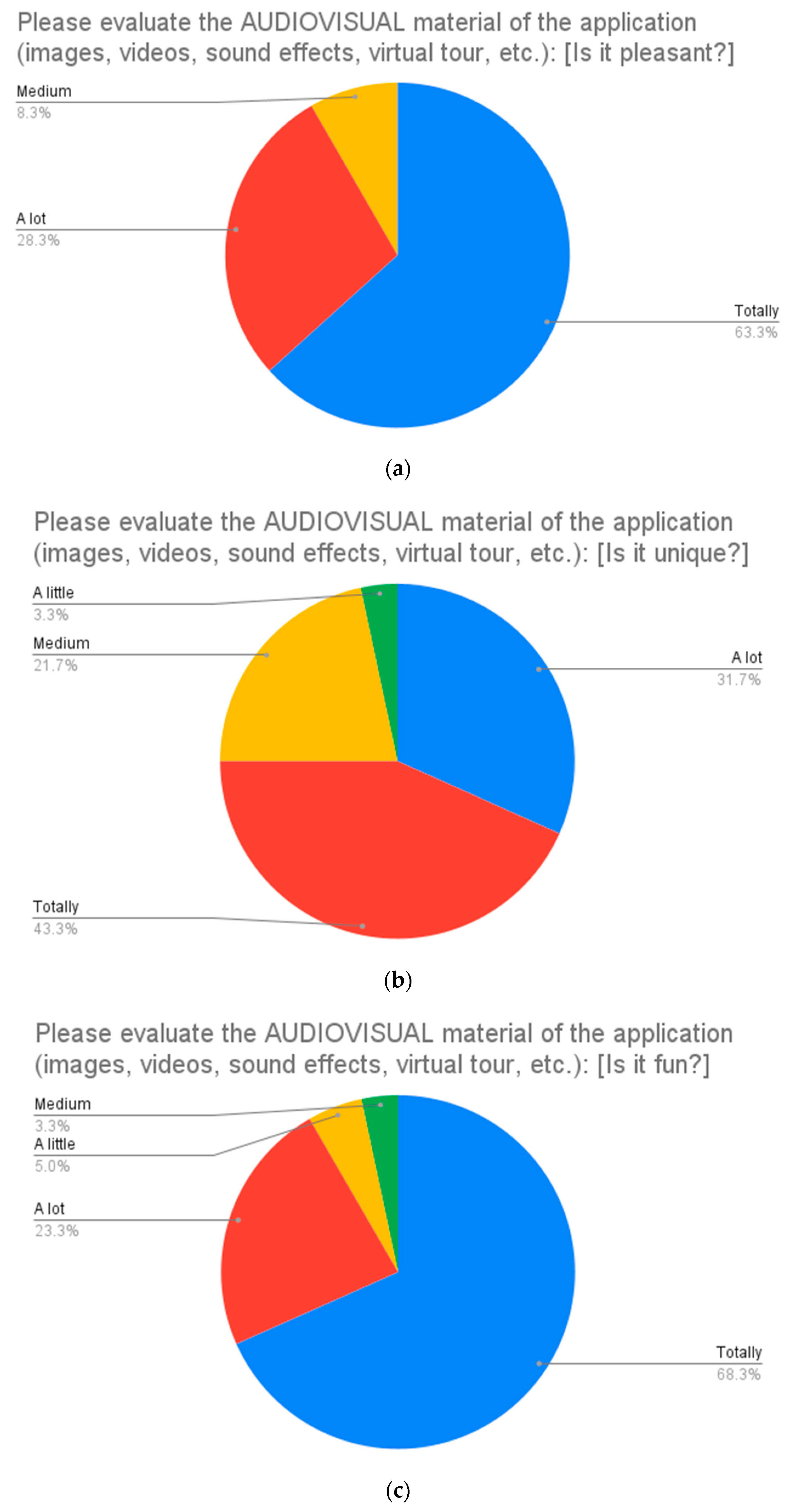
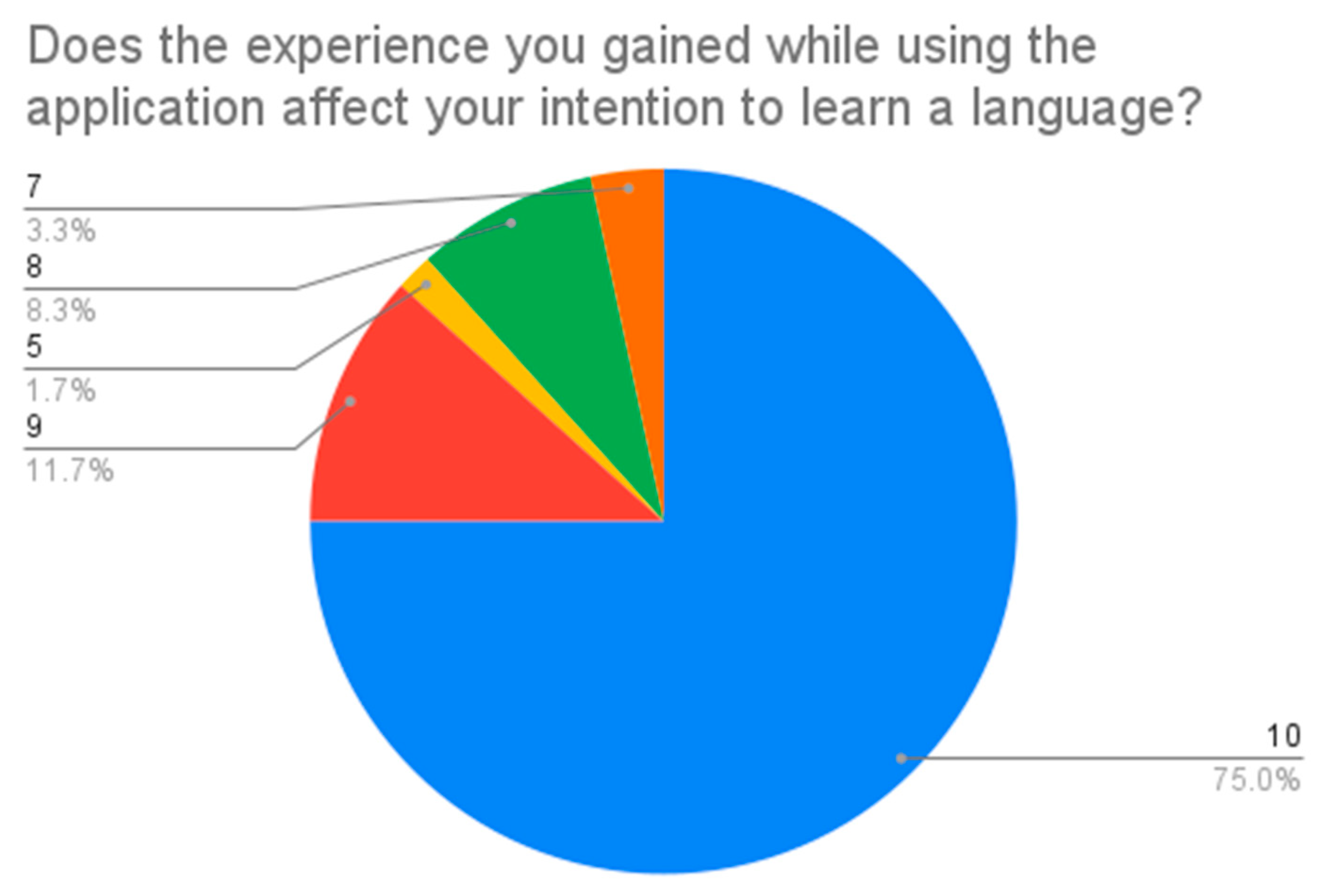
| Educational Toll | Relevance and Authenticity | Proper Navigation | Open Source | User Input | Image and Sound Quality | Platforms | Ages | Multi Language | Collaborative | Extra Features |
|---|---|---|---|---|---|---|---|---|---|---|
| Story Jumper | Medium |  |  |  | Medium | All | 4+ |  |  | Share story |
| Storybird | Medium |  |  |  | High | All | 4+ |  | Visual material | |
| Book Creator | 40 books |  | Medium | iOs | 4+ |  |  | Upload media | ||
| My StoryMaker | Medium |  |  | Medium | All | 5–12 |  | Character-based | ||
| My Storybook | Low |  |  |  | Low | iOs | 4–6 |  | Print the story | |
| Voki | High |  | Only basic |  | Medium | All | 4+ |  |  | 3D animation |
| Kahoot—Drop Language | High |  |  |  |  | All | 4+ |  |  | Drops language tool |
| Edmodo | Medium |  |  |  | Medium | 4+ |  |  | Social network | |
| Mingoville | High |  | Free trial |  | High | All | 4+ |  |  | colourful e-learning environment |
| Mondly kids | High |  |  |  | High | All | 4+ |  |  | Chatbot and speech recognition |
| Educational Toll | Relevance and Authenticity | Proper Navigation | Open Source | User Input | Image and Sound Quality | Platforms | Ages | Multi Language | Collaborative | Extra Features |
|---|---|---|---|---|---|---|---|---|---|---|
| Kahoot—Drop Language | High |  |  |  |  | All | 4+ |  |  | Drops language tool |
| Edmodo | Medium |  |  |  | Medium | 4+ |  |  | Social network | |
| Baamboozle | Medium |  |  | Medium | 4+ |  |  | Swap points | ||
| Mingoville | High |  | Free trial |  | High | All | 4+ |  |  | colourful e-learning environment |
| Mondly kids | High |  |  |  |  | All | 4+ |  |  | Chatbot and speech recognition |
| Educational Toll | Relevance and Authenticity | Proper Navigation | Open Source | User Input | Image and Sound Quality | Platforms | Ages | Multi Language | Collaborative | Extra Features |
|---|---|---|---|---|---|---|---|---|---|---|
| AR Flashcards | Medium |  |  |  | Medium | iOs | 12+ |  | 3D animation | |
| Mondly kids |  |  |  |  |  | All | 4+ |  |  | Chatbot and speech recognition |
| Cathy words AR | Medium |  |  |  | Medium | iOs | 6+ |  | Create your own word list | |
| Narrator | Low |  |  |  | High | All | 8+ |  | Free lesson plans | |
| House of LAnguages AR | Medium | 499€ |  | Low | 10+ |  | Headset and touchpad need | |||
| Immerse Me | Low | 300 €/year |  | Medium | 15+ |  |  | Android Cardboard, Vive, Rift or Gear VR needed | ||
| Virtual Speech | High |  | 45 €/month |  | Medium | 16+ |  |  | Real-life situations | |
| FluentU | High |  | 20 €/month |  | High | All | 15+ |  |  | Audio dialogues are free for offline reading |
| Question | Scale | Mean | Standard Deviation (SD) | Variance |
|---|---|---|---|---|
| Do you like experimenting with new applications? | 1–10 | 8.75 | 1.41 | 1.98 |
| How appealing do you find the design of the application? | 1–10 | 9.41 | 0.85 | 0.72 |
| How would you rate each of the following services of the application? [Graphics] | 1–5 | 4.53 | 0.62 | 0.38 |
| How would you rate each of the following services of the application? [Interaction] | 1–5 | 4.33 | 0.68 | 0.47 |
| How would you rate each of the following services of the application? [Collaboration] | 1–5 | 3.90 | 0.82 | 0.67 |
| How would you rate each of the following services of the application? [Video] | 1–5 | 4.10 | 0.84 | 0.70 |
| Did the app help you understand the language as described during the trial? | 1–10 | 9.48 | 0.96 | 0.93 |
| Would you recommend to a friend to buy the educational app? | 1–10 | 9.13 | 1.27 | 1.61 |
| Does the experience you gained while using the application affect your intention to learn a language? | 1–10 | 9.53 | 0.98 | 0.97 |
Publisher’s Note: MDPI stays neutral with regard to jurisdictional claims in published maps and institutional affiliations. |
© 2022 by the authors. Licensee MDPI, Basel, Switzerland. This article is an open access article distributed under the terms and conditions of the Creative Commons Attribution (CC BY) license (https://creativecommons.org/licenses/by/4.0/).
Share and Cite
Konstantakis, M.; Lykiardopoulou, A.; Lykiardopoulou, E.; Tasiouli, G.; Heliades, G. An Exploratory Study of Mobile-Based Scenarios for Foreign Language Teaching in Early Childhood. Educ. Sci. 2022, 12, 306. https://doi.org/10.3390/educsci12050306
Konstantakis M, Lykiardopoulou A, Lykiardopoulou E, Tasiouli G, Heliades G. An Exploratory Study of Mobile-Based Scenarios for Foreign Language Teaching in Early Childhood. Education Sciences. 2022; 12(5):306. https://doi.org/10.3390/educsci12050306
Chicago/Turabian StyleKonstantakis, Markos, Aggeliki Lykiardopoulou, Electra Lykiardopoulou, Georgia Tasiouli, and Georgios Heliades. 2022. "An Exploratory Study of Mobile-Based Scenarios for Foreign Language Teaching in Early Childhood" Education Sciences 12, no. 5: 306. https://doi.org/10.3390/educsci12050306
APA StyleKonstantakis, M., Lykiardopoulou, A., Lykiardopoulou, E., Tasiouli, G., & Heliades, G. (2022). An Exploratory Study of Mobile-Based Scenarios for Foreign Language Teaching in Early Childhood. Education Sciences, 12(5), 306. https://doi.org/10.3390/educsci12050306






